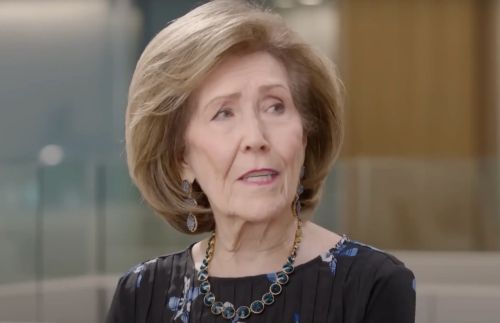

Her life embodied a faith that celebrated divine intervention. But the prosperity gospel she championed carries long, severe consequences.

By Matthew A. McIntosh
Public Historian
Brewminate
A Passing That Revives a Debate
Dodie “Mama Dodie” Osteen passed away on July 30 at the age of ninety. Beloved by her followers and family at Lakewood Church, her death reopened conversations not only about her personal journey but about the theology she embodied. Her “miraculous recovery” from metastatic liver cancer became a foundational narrative in her book Healed of Cancer and in the wider prosperity gospel she helped shape.
That theology promised divine reward for unwavering belief. But beneath that promise lies a quiet harm, a theology that offers blessing to the faithful yet burdens those whose prayers go unanswered.
The Architecture of the Prosperity Gospel
The prosperity gospel emerged in mid‑twentieth century America. It fused Pentecostal fervor, self‑help ideology, and a transactional understanding of faith. In that system blessings are accessed through positive confession and financial generosity.
Dodie Osteen was one of its most human faces. Her story was not just of survival but of proof that faith yields healing. Lakewood Church under Joel Osteen expanded on this, with attendance growing to nearly fifty thousand weekly and millions more tuning into broadcasts. The message of victory and abundance reached deep corners of American evangelicalism even as it cemented a theology of self‑advancement over suffering.
Stories That Do Not Fit the Narrative
Testimonies of healing and financial breakthrough proliferate in prosperity circles. But what of families who gave faithfully and remained in debt? Or patients who died despite declaring their healing? Sociological research shows the prosperity gospel resonates especially within lower‑income communities. A 2017 Lifeway Research study found roughly 38% of Americans reported hearing such teachings, a figure up to 52% in 2023. Congregants facing hardship found hope in promises of divine reversal, but when those didn’t materialize the shame was real.
In that light Dodie Osteen’s testimony became both beacon and burden. Her “healing” offered legitimacy to the faith. Yet for those untouched by miracles, the implication that it was a failure of faith hung heavy.
Cultural and Political Power
The reach of the prosperity gospel extends beyond church. It has shaped the meaning of wealth, poverty, and divine favor within American cultural and political life. Wealth becomes proof of righteousness, poverty a sign of spiritual failure. This worldview aligns neatly with political individualism, one that often dismisses welfare policies as unnecessary.
Dodie Osteen’s life became woven into that logic. Her personal story turned into an ideological tool, reinforcing a gospel of optimism interwoven with consumer culture and political rhetoric of self‑reliance. Critics argue it dilutes Christianity’s call to community, compassion, and solidarity with the suffering.
The Afterlife of a Theology
Dodie Osteen may be gone, but the prosperity gospel thrives. Lakewood Church still broadcasts into homes worldwide. Stadium‑style services continue, and prosperity preachers still pack arenas and social media feeds.
Her legacy remains layered. For many she is a symbol of miraculous grace. But the theology she championed, one that offers hope while often blaming the vulnerable, remains deeply contested.
Megachurch Growth and the Prosperity Message
The influence of Dodie Osteen must be understood within the broader context of megachurch expansion and the reach of prosperity theology in America.
American megachurches, defined as congregations drawing at least 2,000 weekend worshippers, have grown rapidly. As of 2025, there are over 1,200 megachurches nationwide. These often serve middle‑class suburban populations and frequently intertwine with prosperity teachings.
Lakewood Church stands among these giants, with an average weekly attendance of approximately 45,000 worshippers and a televised reach of some 7 million viewers worldwide .
Across the U.S., megachurches congregate largely in fast-growing counties. Over half of counties hosting them saw double-digit population growth between 2010 and 2020. Financially they also wield impressive resources. A 2014 study found that median annual income for megachurches was $4.7 million, covering salaries, building costs and mission efforts .
Meanwhile, belief in prosperity teachings remains widespread. A 2023 Lifeway study found that 76 percent of churchgoers believe God wants them to prosper financially; 43 percent strongly agree with that idea . Yet broader surveys show the theology remains contested: 63 percent of Americans never look to scripture for guidance on wealth, and only 11 percent often do.
These numbers underline a paradox. The theological model promoted by Dodie Osteen sits within massive institutional forms shaped by media, money, and rapid church growth. It persists not in spite of evidence but because it thrives in the emotional architecture of hope and success.
Conclusion
Dodie Osteen’s passing invites both remembrance and reckoning. Her life embodied a faith that celebrated divine intervention. But the prosperity gospel she championed carries long, severe consequences.
It has become a cultural force, amplified through megachurches and media, shaping how communities interpret blessing and suffering. As it endures, so does the question: at what point does faith become a ledger of spiritual wealth rather than a practice of collective care?
Originally published by Brewminate, 09.05.2025, under the terms of a Creative Commons Attribution-NonCommercial-NoDerivatives 4.0 International license.


